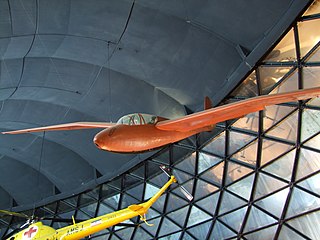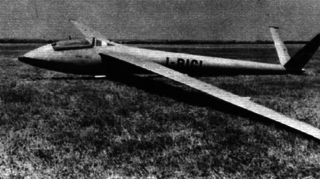Related Research Articles

The Aero Boero AB-115 is an Argentine civil utility aircraft. It was developed from the AB-95-115, a refined AB-95 with a more powerful engine and improved aerodynamics. Specific differences included wheel spats, a redesigned engine cowling molded of fiberglass, and aluminum ailerons and flaps.

The Mahindra Airvan 8 is a single-engined utility aircraft manufactured by GippsAero of Victoria, Australia. It can seat up to eight people, including the pilot.

The Rolladen-Schneider LS4 is a Standard Class single seat glider manufactured by Rolladen-Schneider Flugzeugbau GmbH between 1980 and 2003.

The Schempp-Hirth Janus is a high performance two-seat glider that was built by Schempp-Hirth GmbH. It was the first high-performance two-seater.

The Aero-Service Puma is a Polish ultralight aircraft, designed and produced by Aero-Service Jacek Skopiński of Warsaw. The aircraft is supplied complete and ready-to-fly.

The Dyn'Aéro CR.100 is a French kit built single engine, two-seat monoplane, developed in the 1990s and intended as both an aerobatic trainer and a tourer, primarily for aero club use.

The Glaser-Dirks DG-600 is a glider manufactured by Glaser-Dirks as a successor to the DG-202 and DG-400 series of gliders where carbon fiber reinforced plastics was used.

The GippsAero GA10 Airvan, marketed as the Airvan 10, is a 10-seat, turbo prop, single-engined utility aircraft currently being developed by GippsAero of Victoria, Australia.
The Akaflieg Darmstadt D-40 is an experimental variable geometry single seat sailplane, fitted with almost full span, camber changing flaps for optimum aerodynamics in weak thermals and integrated into the wing so as to minimise flap tip drag. One flew successfully but the D-40, like other variable geometry sailplanes, was not commercialised.

The Timm T-840 was a twin engine, high wing passenger aircraft designed and flown in the United States in 1938. Equipped with a tricycle undercarriage and low speed aerodynamic devices, it could be configured to carry between six and ten passengers. Only one was built.

The Ikarus Košava is a two-seat sailplane designed and built in Yugoslavia in the early 1950s. It won the 1954 World Gliding Championships in the two seat category and came second in the same event two years later.
The Texas A&M College Ag-1 was a prototype single seat, single engine aircraft, one of the first specifically designed for agricultural spraying, dusting and fertilizer spreading. It was the first of a series of designs that led to the Piper PA-25 Pawnee.
The Akaflieg Braunschweig SB-8 is an experimental, single-seat, high performance glider built in Germany in the 1960s, constructed largely from glass fibre skin over built up balsa wood structure. Two were built; the second of which was later fitted with a high aspect ratio (30:1) wing, becoming the Akaflieg Braunschweig SB-9 Stratus.

The SZD-42 Jantar 2 is a single seat Open Class competition glider, designed and produced in Poland in the 1970s. It features a span of over 20 m (66 ft) and elastic, camber changing flaps. It was placed second, third and seventh at the 1976 World Gliding Championships. Over one hundred were built and more than ninety remain registered.

The Bruni 3V-1 Eolo was a single seat Italian competition glider, first flown in 1955. It took part World Gliding Championships of 1956 but retired early after sustaining damage.
The Rihn DR-109 is an American aerobatic homebuilt aircraft that was designed by Dan Rihn. The aircraft was supplied by Jim Kimball Enterprises of Zellwood, Florida and more recently by Ashcraft Aero Works of Aurora, Illinois in the form of plans. It was designed for competition aerobatics as well as a trainer for the Rihn DR-107 One Design.
The Explorer Ellipse is an American homebuilt aircraft that was designed by Dean Wilson and produced by Explorer Aviation of Grangeville, Idaho. When it was available the aircraft was supplied as a kit for amateur construction.
The Storm 320E, sometimes written Storm 320 E, is an Italian microlight aircraft that was designed and produced by Storm Aircraft of Sabaudia. Storm Aircraft was originally called SG Aviation srl. When it was available the aircraft was supplied as a kit for amateur construction.
The Chasle LMC-1 Sprintair is an all-metal, single-seat sports light aircraft designed in France in the early 1970s and intended to be built by aero clubs from plans.
The V-STOL Pairadigm is an American twin-engine center-line thrust STOL homebuilt aircraft that was designed and produced by V-STOL Aircraft Corporation of Fort Myers, Florida, introduced in the late 1990s. When it was available the aircraft was supplied as a kit for amateur construction.
References
- ↑ Jackson 2003, pp. 5–6.
- ↑ Jackson, Paul, ed. (2000). Jane's all the World's Aircraft 2000–01 (91st ed.). Coulsdon, Surrey, United Kingdom: Jane's Information Group. pp. 5–6. ISBN 978-0710620118.
- Jackson, Paul (2003). Jane's All the World's Aircraft 2003–2004. Coulsdon, UK: Jane's Information Group. ISBN 0-7106-2537-5.